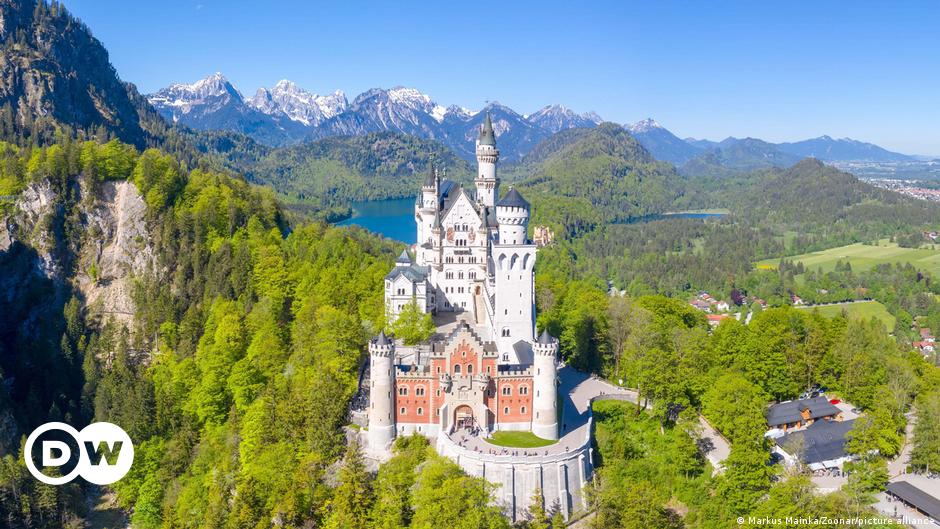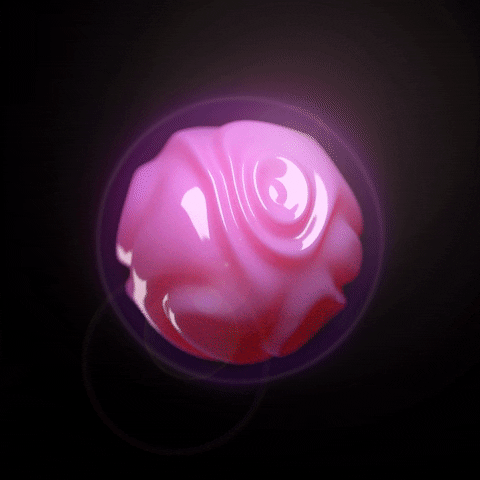Perched on a cliff in the Bavarian Alps near Füssen, Germany, the Neuschwanstein Castle is the epitome of the idyllic. Its spires soar to the heavens, while the surrounding landscapes are an invitation to daydreaming. It’s the stuff of fairytales, so much so that the man who had it built is dubbed the “fairytale king” — Ludwig II of Bavaria, who was born in 1845.
“Neuschwanstein is nestled in this Alpine landscape. Reminiscent of a theatrical setting, Ludwig II aimed to unite architecture, art and landscapes into a Gesamtkunstwerk — a complete artwork,” Alexander Wiesneth, of the Bavarian Palace Administration, told DW.
Just weeks after the mysterious death of Ludwig II in 1886, Neuschwanstein was opened to the public. It was an ironic twist of fate, as the king had it built as a private refuge for himself, desperately seeking solitude
Modeled as a medieval knight’s castle, inspiration for Neuschwanstein came during Ludwig II’s travels in 1867 to Wartburg Castle near Eisenach, Germany and to Chateau de Pierrefonds in France.
As the eccentric Ludwig II himself wrote to his revered friend, opera composer Richard Wagner, in May 1868:
“It is my intention to rebuild the old castle ruin […] near the Pöllat Gorge in the authentic style of the old German knights’ castles, and I must confess to you that I am looking forward very much to living there one day,” as the Bavarian Palace Administration
Construction of the “new castle” that was to include 200 rooms began in September 1869 and continued over decades, but was never fully completed.
The building melded various styles that included towers, chapels and arches, but also featured modern innovations like central heating, flushing toilets and a bell system to summon servants.
Neuschwanstein’s design was also dedicated to Wagner, whose operas “Tannhäuser,” “Lohengrin” and “Parsifal” profoundly influenced Ludwig.
The Singers’ Hall boasts gilded frameworks and frescoes depicting knights, courtly love and other legends of medieval times, like the Holy Grail. The ceiling features zodiac signs, while wall images show Parsifal’s son, the “Swan Knight” Lohengrin. Ludwig II himself had identified with such figures since his youth
Yet these majestic rooms, like the Throne Hall and the Ballroom — begging to be filled with illustrious guests and lavish parties — remained empty. In the end, the king simply wanted his peace.
With the construction of Neuschwanstein dragging on over many years, Ludwig himself only lived there briefly before his mysterious death at the age of 40 — officially ruled to be a suicide by drowning, a theory that has, however, been disputed.
Ludwig II’s lifeless body was discovered floating in Lake Starnberg, near Munich, along with the corpse of his physician, after the two had set out on an evening stroll in June 1886.
But it’s not just Neuschwanstein’s lavish, fairy-tale design that has made the castle famous.
Its role as a depot for Nazi-looted artworks during World War II has also made it rather infamous, as featured in George Clooney’s 2014 film “The Monuments Men.”
After German troops invaded neighboring France in 1940, Adolf Hitler authorized the taskforce led by Alfred Rosenberg to “search libraries, archives, lodges and other philosophical and cultural institutions of all kinds for appropriate material and to seize such material,” which included cultural holdings by Jews, as noted on the Smithsonian Institution’s American Archives of Art and at the United States Holocaust Memorial Museum
sites.
Between 1940 and 1945, Nazi officials transferred stolen valuables, primarily from Jews, to locations throughout Europe, and later, to Germany, including salt mines, monasteries and castles.
Neuschwanstein Castle was ideal as a depot and site for the Rosenberg taskforce headquarters. Tucked away near the Austrian border, far from the capital Berlin or other likely Allied targets, it provided ample space.
Ultimately, when Allied forces stormed Neuschwanstein in 1945, they unearthed catalogues, photo slides and lists documenting more than 20,000 artworks and other pieces that had been stolen by the Nazis, including Rothschild jewelry and furniture, as well as the “Ghent Altarpiece” masterpiece by the Van Eyck brothers
Many of these items had stemmed from France. It was due to the valiant efforts of French curator Rose Valland that the Allied task force discovered the Neuschwanstein cache in the first place, said one of the “Monuments Men,” art historian S. Lane Faison Jr., in an interview
found at the Archives of American Art.
“She pretended to be a [Nazi] collaborator,” Faison noted of Valland, who worked at the Jeu de Paume Museum in Paris, one of the Nazis’ collection points before they shipped stolen wares to Germany.
For years, Valland had secretly tracked where the art was being transported and her meticulous records auspiciously landed in the hands of Allied forces.
Toward the end of the war, the Munich Central Collecting Point (MCCP) was established, with the aim of returning artworks looted by the Nazis to their rightful owners.
Matthias Memmel, responsible for provenance research at the Bavarian Palace Administration, stressed to DW with regard to “The Monuments Men” that “Neuschwanstein Castle was happy to cooperate with the film project, as it made the historical merit of the American Allies, the ‘Monuments Men,’ better known to a broad international public.”
Maria Blenk, Bavarian Palace Administration museum specialist, explained to DW that visitors do ask questions about Neuschwanstein and the Second World War. “Americans in particular, but also British people, remember the history of the ‘Monuments Men’ and many have or had family members who were stationed in Bavaria, so they are interested in the more recent history of Neuschwanstein.”
Neuschwanstein was only one of Ludwig II’s lavish construction projects. Others include the rococo Linderhof Palace and the baroque Herrenchiemsee Palace. Together, they are up for consideration as a UNESCO World Heritage site.
Whether the dream of a king, the site of a former Nazi-looted art depot or as the inspiration for Walt Disney’s Cinderella and Sleeping Beauty castles, Neuschwanstein remains in the imaginations of many. As the Bavarian Palace Administration’s Alexander Wiesneth notes, the similarity between King Ludwig II and Walt Disney is clear: Their vision of architecture was about “telling a story.”
Not exactly world news related…
My favorite part of the story of Ludwig II was that he basically bankrupted the region building these castles. He was found dead floating in the moat surrounding the castle, and there was basically no investigation. Everyone was like “meh, case closed” and moved on with life hahaha.
Erm, sorry, but I fail to see the news here? It’s a nice information about neuschwanstein, but what exactly happened now?
I visited this castle recently and it’s pretty gorgeous - a lot smaller on the inside than you’d think, and the tour basically is designed to get you in and out as fast as possible. But the view from the back windows after the tour is complete is a stunning vista worthy of a lot of photos. The walk up to the base of the castle is very picturesque, and there’s options to take a horse & carriage ride up, if you’re in a rush.
If you ever visit Munich, I highly recommend visiting as a day-trip!
This is the best summary I could come up with:
Reminiscent of a theatrical setting, Ludwig II aimed to unite architecture, art and landscapes into a Gesamtkunstwerk — a complete artwork," Alexander Wiesneth, of the Bavarian Palace Administration, told DW.
The building melded various styles that included towers, chapels and arches, but also featured modern innovations like central heating, flushing toilets and a bell system to summon servants.
After German troops invaded neighboring France in 1940, Adolf Hitler authorized the taskforce led by Alfred Rosenberg to “search libraries, archives, lodges and other philosophical and cultural institutions of all kinds for appropriate material and to seize such material,” which included cultural holdings by Jews, as noted on the Smithsonian Institution’s American Archives of Art and at the United States Holocaust Memorial Museum sites.
Ultimately, when Allied forces stormed Neuschwanstein in 1945, they unearthed catalogues, photo slides and lists documenting more than 20,000 artworks and other pieces that had been stolen by the Nazis, including Rothschild jewelry and furniture, as well as the “Ghent Altarpiece” masterpiece by the Van Eyck brothers.
Whether the dream of a king, the site of a former Nazi-looted art depot or as the inspiration for Walt Disney’s Cinderella and Sleeping Beauty castles, Neuschwanstein remains in the imaginations of many.
As the Bavarian Palace Administration’s Alexander Wiesneth notes, the similarity between King Ludwig II and Walt Disney is clear: Their vision of architecture was about “telling a story.”
The original article contains 1,022 words, the summary contains 227 words. Saved 78%. I’m a bot and I’m open source!
Also used as the cover photo for Blur’s Country House. Although as a mirror image.




